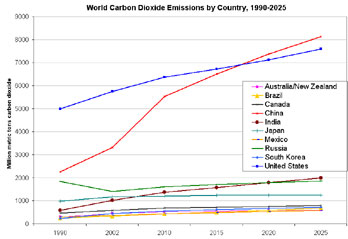Supreme Court rebukes Bush Administration on global warming
Supreme Court rebukes Bush Administration on global warming
mongabay.com
April 2, 2007
The U.S. Supreme Court ruled against the Bush Administration in a landmark case with global warming implications. In Massachusetts v. EPA, the Supreme Court ruled 5-4 that (1) state governments and environmental groups have the right to sue the EPA, and (2) the EPA has the right to regulate CO2 emissions as a pollutant under the Clean Air Act. On a third point, where the EPA can choose not to regulate CO2 emissions, the Supreme Court directed the agency to “reconsider its refusal based on the factors set forth in the law.”
“In short, EPA has offered no reasoned explanation for its refusal to decide whether greenhouse gases cause or contribute to climate change,” wrote Justice John Paul Stevens for the majority.. “Its action was therefore ‘arbitrary, capricious… or otherwise not in accordance with law.'”
Until now, the Bush Administration had maintained that the Environmental Protection Agency lacked the authority to set new emissions rules because greenhouse gases such as carbon dioxide, which contribute to global warming by trapping heat in the Earth’s atmosphere, are not covered by air pollution laws.

|
“Despite acknowledging that global warming poses serious dangers to our environment and health, the Bush Administration has done little or nothing to regulate greenhouse gas emissions,” said Martha Coakley, Attorney General of Massachusetts, the state that led the suit. “As a result of today’s landmark ruling, EPA can no longer hide behind the fiction that it lacks any regulatory authority to address the problem of global warming.”
“While today’s ruling does not itself require EPA to issue emission standards for greenhouse gases, it will be difficult for EPA to refuse such regulation once it applies legally permissible factors,” she continued. “The Supreme Court today established that the agency cannot refuse to use its existing authority to regulate dangerous substances simply because it disagrees that such regulation would be a good idea.”
In addition to Massachusetts, 27 parties brought the case including eleven other states: California, Connecticut, Illinois, Maine, New Jersey, New Mexico, New York, Oregon, Rhode Island, Vermont, and Washington; three cities: the District of Columbia, New York City, and Mayor and City Council of Baltimore; the American Samoa Government; and thirteen environmental groups: Center for Biological Diversity, Center for Food Safety, Conservation Law Foundation, Environmental Advocates, Environmental Defense, Friends of the Earth, Greenpeace, International Center for Technology Assessment, National Environmental Trust, Natural Resources Defense Council, Sierra Club, Union of Concerned Scientists, and U.S. Public Interest Research Group.

Recent rise in atmospheric CO2 levels |
Opposing these parties were nine states: Michigan, Texas, North Dakota, Utah, South Dakota, Alaska, Kansas, Nebraska, and Ohio; four motor vehicle-related trade associations (the Alliance of Automobile Manufacturers; National Automobile Dealers Association; Engine Manufacturers Association; and Truck Manufacturers Association); a group of utility interests known as the Utility Air Regulatory Group (composed of many individual electric generating companies and various national electric utility trade associations: the American Public Power Association, the Edison Electric Institute, the National Rural Electric Cooperative Association, and the National Mining Association) and an industry group known as the CO2 Litigation Group (composed of: American Petroleum Institute, American Forest & Paper Association, American Iron & Steel Institute, the Business Roundtable, the Chamber of Commerce of the United States of America, National Association of Convenience Stores, National Association of Manufacturers, National Petrochemical & Refiners Association, Portland Cement Association, Society of Independent Gasoline Marketers of America, Specialty Steel Industry of North America, and Steel Manufacturers Association.)
Environmentalists hailed the decision.
“This is a huge, huge deal. The proximate effect is that California’s pioneering efforts against climate change are safe from federal interference,” wrote David Roberts of Grist.org. “More broadly, the Supreme Court has put the weight of the judicial branch of the federal government behind the effort to fight global warming. There is no longer a shred of doubt, if there was any left, that federal action is inevitable.”
U.S. emissions
The U.S. transportation sector produced about 6 percent of global carbon emissions and around a third of total U.S. energy-related carbon-dioxide emissions in 2005, according to the Department of Energy’s Energy Information Administration (EIA). EIA figures show that in 2005 total U.S. greenhouse gas emissions rose to 7,147 million metric tons, a new record. About 83 percent of total U.S. greenhouse gas emissions in 2005 consisted of carbon dioxide from the use of fossil fuels including coal, petroleum, and natural gas.
The U.S. is the largest producer of carbon dioxide. China, the number two emitter, is expected to surpass the United States this year or next, though its emissions per capita will still less than a quarter of that of the U.S.
Overall, atmospheric CO2 levels have climbed by more than 35 percent since the beginning of the industrial revolution. Fossil fuel combustion, which releases carbon dioxide into the atmosphere, and land-use change, including deforestation, is blamed for the rise. Roughly 75-80 percent of anthropogenic carbon dioxide results from fossil fuel burning, while about 20-25 percent is produced by deforestation. The United States, the world’s largest economy and consumer of energy, produces about 24% of global carbon dioxide emissions.
Scientists believe rising levels of carbon dioxide and other greenhouse gases are causing Earth’s atmosphere to warm. Research released last year by NASA, WMO, and the National Academy of Sciences found that 2005 was the warmest year in at least the 400 years, and possibly much longer. The WMO said that carbon dioxide has accounted for 90 percent of warming over the past decade.
The Intergovernmental Panel on Climate Change (IPCC) projects that atmospheric carbon dioxide levels could rise to 450-550 ppm by 2050, possibly resulting in higher temperatures, rising sea levels, stronger storms and hurricanes, and expanding deserts.
Related articles
